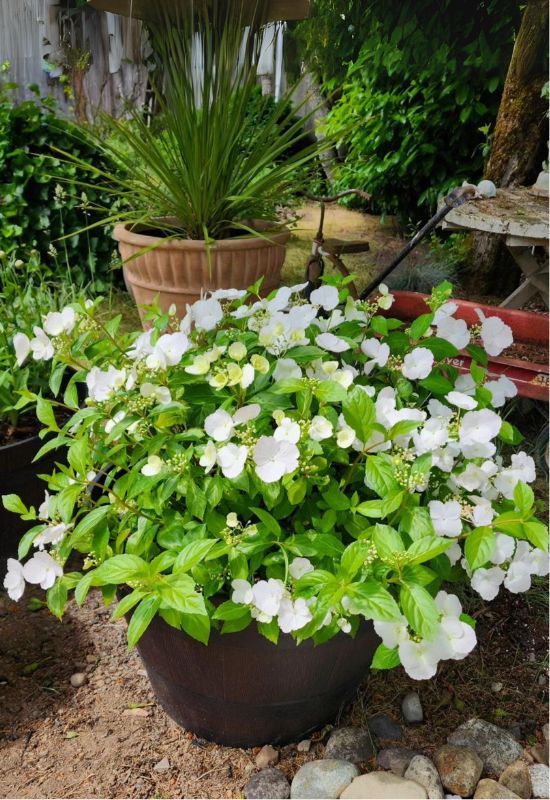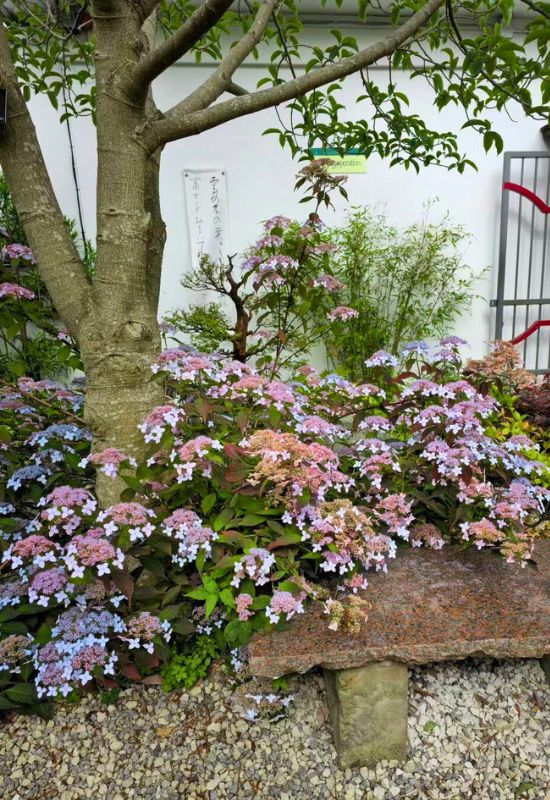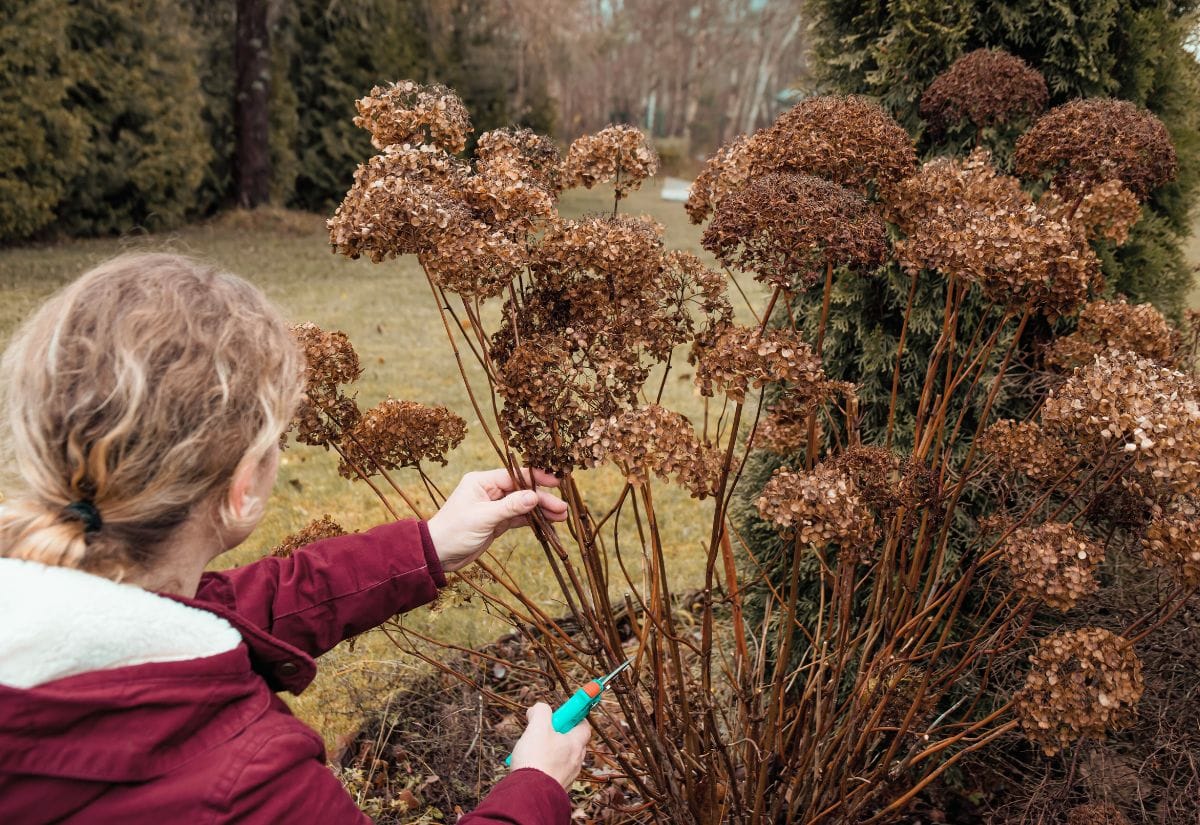
Feeling anxious about pruning your Hydrangeas? You’re not alone. Many people dread and feel confused about pruning hydrangeas, unsure about when and how to prune their hydrangea plants. They often fear that incorrect pruning might ruin the blooms for the next year.
The trick to successful pruning lies in knowing what species you have, and whether it blooms on old wood or new wood. These plants vary greatly in terms of size, growth patterns, flower colors, and their specific pruning needs. Identifying your Hydrangea’s variety is crucial because it influences how and when you should prune, or if you need to prune at all. All you have to know is two things: what species you have, and whether it blooms on old wood or new wood.
But hey, no need to worry! I’ve got a no-fail guide that’s going to make pruning these show-stoppers a breeze. This guide will walk you through the exact steps on how and when to prune your hydrangeas, ensuring that you get those gorgeous blossoms year after year. So, let’s roll up our sleeves and get your Hydrangeas ready for their best show yet!
New Wood or Old Wood, or New Wood and Old Wood?
Despite their common name, Hydrangeas are not all the same. Some Hydrangeas bloom on old wood, that is, stems that were produced on the previous year’s growth. They generally bloom in early summer. They should be pruned in late summer, after flowering – or around early August. Pruning them any later will eliminate next year’s flowers.
Other Hydrangeas bloom on new wood – stems that are produced during the current season’s growth. They generally bloom a little later in the year, from late summer to frost. They should be pruned in winter, before new growth starts. Pruning them in the spring will cut off all the potential flower buds.
Still other Hydrangeas bloom on both old wood and new wood. These are the easiest to take care of because they can be pruned back at any time and will still bloom.
Group 1: Hydrangeas That Bloom on Old Wood
Some Varieties: ‘Berlin’, ‘Paris’, ‘Mars’
Some Varieties: ‘Gatsby Gal’, ‘Ruby Slippers’, ‘Snow Queen’
Some Varieties: ‘Firefly’, ‘Miranda’, ‘Silver Lining’
Varieties: ‘Fairytrail Bride’
1. Hydrangea macrophylla
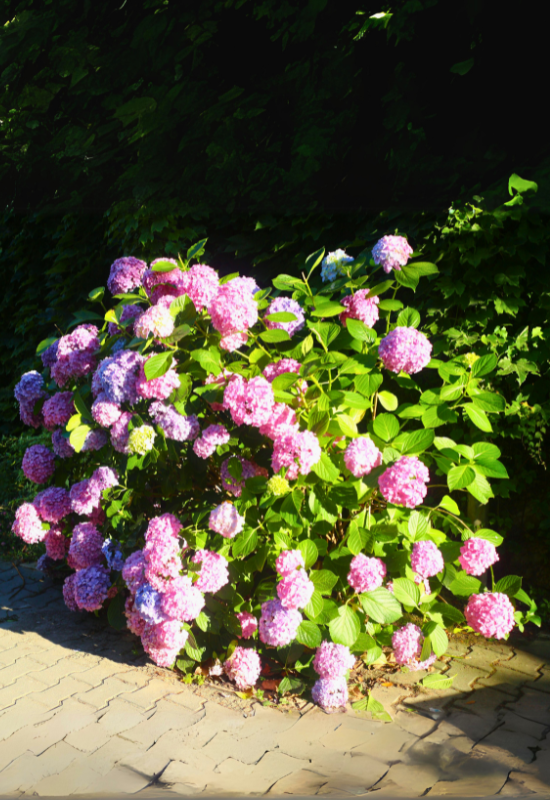
Big Leaf Hydrangeas are the plants we visualize when we think of Hydrangeas. They are the mopheads and lace caps, with colorful, large, flamboyant flowers in red, pink, purple and blue.
Hydrangea macrophylla forms floral buds in late summer or early fall (late August to September), when days are shorter and temperatures begin to cool. The buds remain dormant over the winter and open in late spring or early summer of the following year.
Prune Big Leaf Hydrangeas back in late summer, around early August, after flowering has ended, and certainly no later than mid-August, allowing them time to produce strong new shoots from the base. Remove the oldest stems and all dead wood down to the soil level. This maintains vigor and encourages larger flowers. Remove all thin, weak shoots, whether new or old, down to their base. Leave on all the stronger stems – the new ones as well as the old ones. If you want to control the height of the plant, cut these remaining stems by one third to one half by making heading cuts.
When cutting them, make sure to cut no more than one-quarter of an inch above a set of buds. Leaving more than a quarter inch will create an entry point for diseases.
Any stems that are thick and stunted, with numerous, thin, short side branches, should also be cut back to its base. These will never produce any strong stems or flowers.
Deadhead faded and spent flowers throughout the season. Eliminating them allows energy to flow into the production of new stems, roots and leaves instead of making seeds. To deadhead, cut the stem just above the 1st set of leaves below the flower head.
A note about deadheading.
Deadheading is beneficial for all these Hydrangeas, and makes for neater looking plants. However, if you like the look of old, spent flowers in the winter landscape, by all means, leave them on until the spring. It certainly won’t hurt them.
2. Hydrangea quercifolia
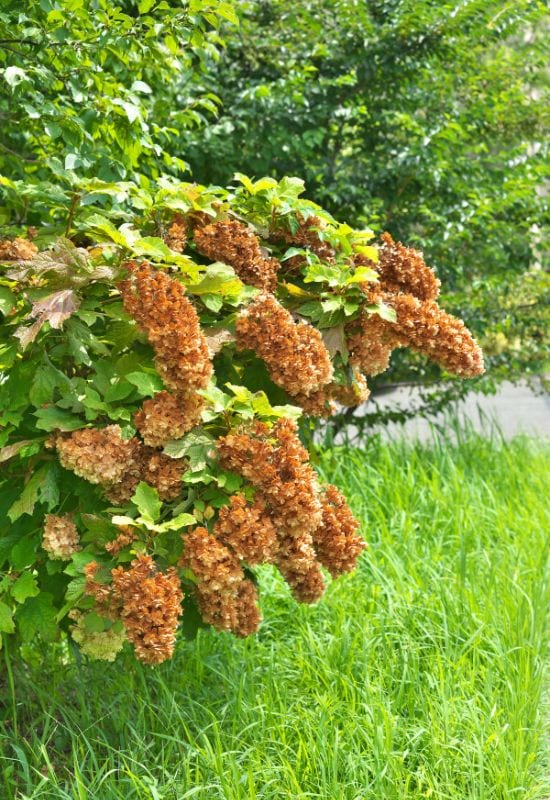
Oak Leaf Hydrangea is native to the southeastern United States. It can grow to eight feet or more, covered with large oak shaped leaves that turn a red-burgundy color in the fall. The flowers are conical in shape and usually white, turning a pinkish hue as they age.
Little pruning is recommended for Oak Leafs, their natural form being more desirable. Just remove the dead wood and any errant branches. If you want to contain it, do some light pruning in late summer. Remember to cut just above a bud, leaving no more and one fourth inch above it.
3. Hydrangea petiolaris

Climbing Hydrangea is an oddity, attaching itself to a support to gain height as a vining plant rather than a shrub. It has gnarly, multiple stems and branches, and grows in thick tangles up to about thirty to fifty feet. Climbing Hydrangea needs only light pruning, mostly cleaning out dead wood and any wild, hanging branches.
Climbing Hydrangea can tolerate heavy pruning, if necessary, which should be done in early spring, around March, before it leafs out. Cut back unwanted branches to a main stem. Remember, though, pruning at this time will inevitably decrease the number of blooms. If you do need to do a lot of hard pruning, it is better to do so in stages, over a three or four year period, to maintain good health.
Light pruning as the plant grows keeps it tidy and manageable, but it will reduce flowers. Climbing Hydrangea is grown mainly for its foliage, though, flowers being an added treat.
4. Cascade Hydrangea
Cascade Hydrangea (there is only one variety, as of this writing – ‘Fairytrail Bride) is unique, in that it spreads more horizontally, producing flower buds along the whole length of its branches. It is a hybrid, the result of a breeding program that involved multiple species and varieties.
Although Cascade Hydrangeas flower on old wood, pruning is not recommended, except for cleaning out dead wood. If you want to improve its habit or shape, or thin it, however, entire branches can be removed, but pruning back will affect flowering in this season and the next.
Group 2: Hydrangeas That Bloom on New Wood
Varieties: ‘Limelight’, ‘Bolo’, ‘Pink Diamond’, ‘Tardiva’, ‘Quickfire’
Varieties: ‘Bounty’, ‘Incrediball’ Series
5. Hydrangea paniculata
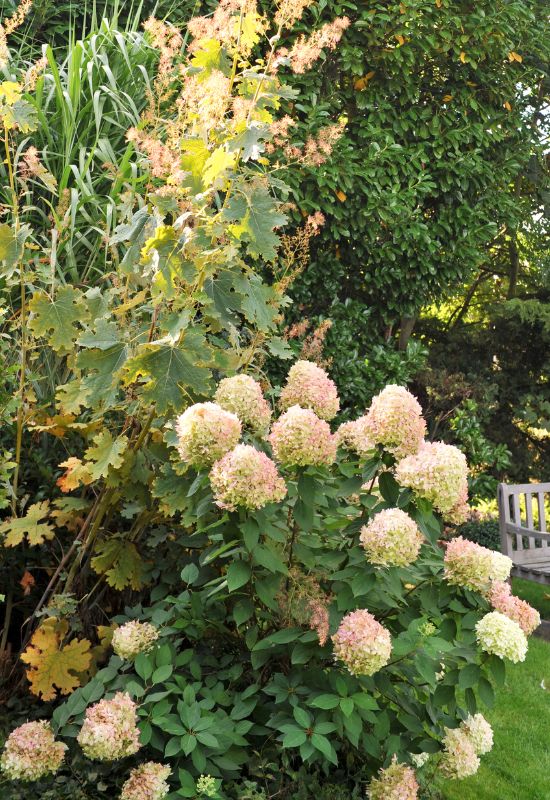
Panicle Hydrangea, H. paniculata, better knowns as peegee hydrangea, is a very beautiful shrub, with cone to football shaped flower heads that start out white and turn a nice pink or reddish-pink color as they age. It blooms in early spring, and is one the earliest here in Florida.
Pruning done very late winter or early spring, but no later than just after the last frost, will help initiate growth as the weather warms. Start by removing all the dead branches and then cut back the remaining ones to about one third. Panicle Hydrangea will accept a harder prune to the ground, however.
Deadheading is recommended, but you can leave the old flowers on as late as possible. I recommend leaving the dry, tan flowerheads on the plant to provide winter interest. Some people don’t prune Panicle Hydrangea at all, except for removing dead wood, opting to let the plant grow in its own natural way.
If you want a show of big flowers, prune Panicle Hydrangea to a framework of stems. You can do this by making heading cuts – cutting back each of last year’s stems to a pair of buds about ten to twenty inches above the soil level. The sturdy framework of stems will support each other and the heavy flower heads that will form, keeping them from laying on the ground.
H. paniculata can also be pruned into a tree form, making a fine accent plant in the right location. Just cut most of the stems back to the ground, leaving the three strongest stems to form the support frame for the eventual top. Cut out any side branches that form on the support stems as they grow upward and increase in diameter.
When the support stems are about three feet high, encourage side branches to form and start growing outward to fill out the top. Cut off branches that are growing inward toward the center and gradually shape the top until it is three or four feet wide and at least as much high. You can train the plant into a tree form at any time but, if you also want flowers, do the pruning in stages during regular pruning time.
6. Hydrangea arborescens
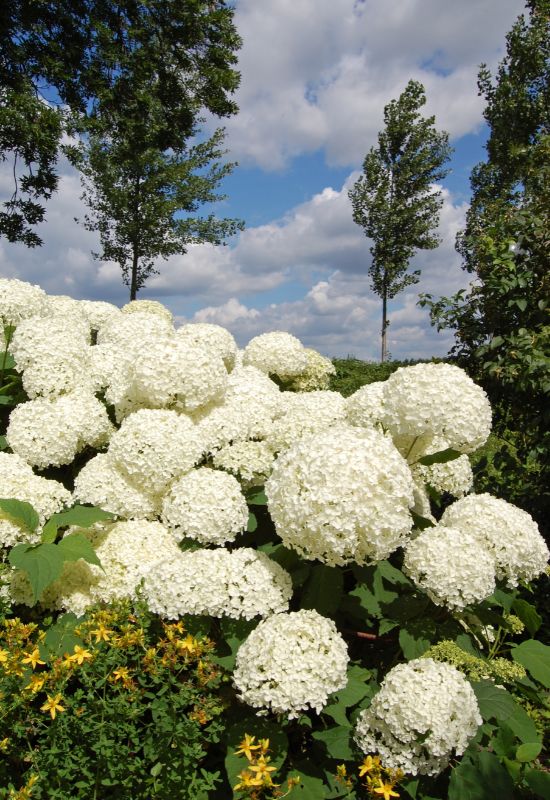
Smooth Hydrangea is another beautiful, dense shrub with large, globe shaped flowers, blooming late spring to mid-summer, April to July. It may well keep blooming until the first frost. Most of the varieties of Smooth Hydrangea are white, but a few of the more recent varieties are pink in color. Some of the newer additions are re-bloomers, also.
New buds form a few weeks before it begins leafing out. Pruning should be done mid winter to early spring, or December to mid March. Fall is ok, too, but shouldn’t be done too late because pruning does stimulate new growth and new, tender growth late in the season could be damaged by early frosts.
Cut the stems back to one fourth to one half, although cutting back to one foot, or even to just a few inches won’t hurt it. Cut out all dead wood. Remember, as with Panicle Hydrangeas, you can also cut back to fewer framework stems, increasing the size of the blooms, but doing so will be at the expense of a larger number of flower heads.
This is another Hydrangea that looks good without any pruning, except for removing dead wood. It’s natural laid back, relaxed appearance fits in well with cottage gardens.
Hydrangeas That Bloom on New and Old Wood
Varieties: ‘Endless Summer’ Series, ‘Rhythmic Blue’, ‘Eclipse’
Varieties: ‘Incrediball Blush’, ‘Annabelle’, Invincibelle’
‘Tuff Stuff’ Series, ‘Bluebird’, ‘Pink Dynamo’, ‘Arriba’
This group contains varieties of Hydrangeas we’ve already covered before, H. macrophylla and Hydrangea Paniculata, as well as a new one, Hydrangea serrata, the Mountain Hydrangea.
These Hydrangeas bloom on old as well as new wood. It really doesn’t matter at all when you prune them, they will still bloom. If you cut them back in the late fall, removing all the buds they produced during late summer, they will still bloom off buds produced the next spring. If you prune them in early summer, removing buds produced in the early spring, they will bloom the following spring off buds produced in the fall. They’ve got you covered!
7. Hydrangea serrata
Mountain Hydrangeas are tough plants, originally from mountainous areas of Japan, and provide a long flowering season, from spring until fall, April to September. They are more compact and lower growing than the other types discussed here, so they’re great for smaller gardens.
They are also more reliable than Big Leafs for areas prone to early or late freezes. Big Leaf Hydrangeas can lose an entire season’s flower buds with an early freeze, while the buds of Mountain Hydrangeas will probably make it through unscathed.
Pruning is not recommended for Mountain Hydrangeas, aside from cleaning up dead and unproductive wood, which can be cut to the base of the plant whenever necessary.
General Considerations When Pruning All Varieties
Just a couple of notes here. The only tools you will probably need are hand pruners for lighter branches and loppers for the heavier stems. Make sure the cutting tools are sharp and clean, because dull tools can damage the plant and lead to disease. You can clean the blades with rubbing alcohol. A ten percent solution of bleach can be used to sanitize the cutting blade in between plants, but it’s probably not necessary – especially if the tools are sharp.
Hydrangeas are exceptional garden plants. They are a varied group, in size, habit, flower color and, most especially, in the way they should be pruned. Pruning them at the wrong time can lead to loss of blooms, or no blooms at all. But, getting to know them individually, and how they bloom will enable you to prune them properly and enjoy them for many years.

Written By
Amber Noyes
Amber Noyes was born and raised in a suburban California town, San Mateo. She holds a master’s degree in horticulture from the University of California as well as a BS in Biology from the University of San Francisco. With experience working on an organic farm, water conservation research, farmers’ markets, and plant nursery, she understands what makes plants thrive and how we can better understand the connection between microclimate and plant health. When she’s not on the land, Amber loves informing people of new ideas/things related to gardening, especially organic gardening, houseplants, and growing plants in a small space.

